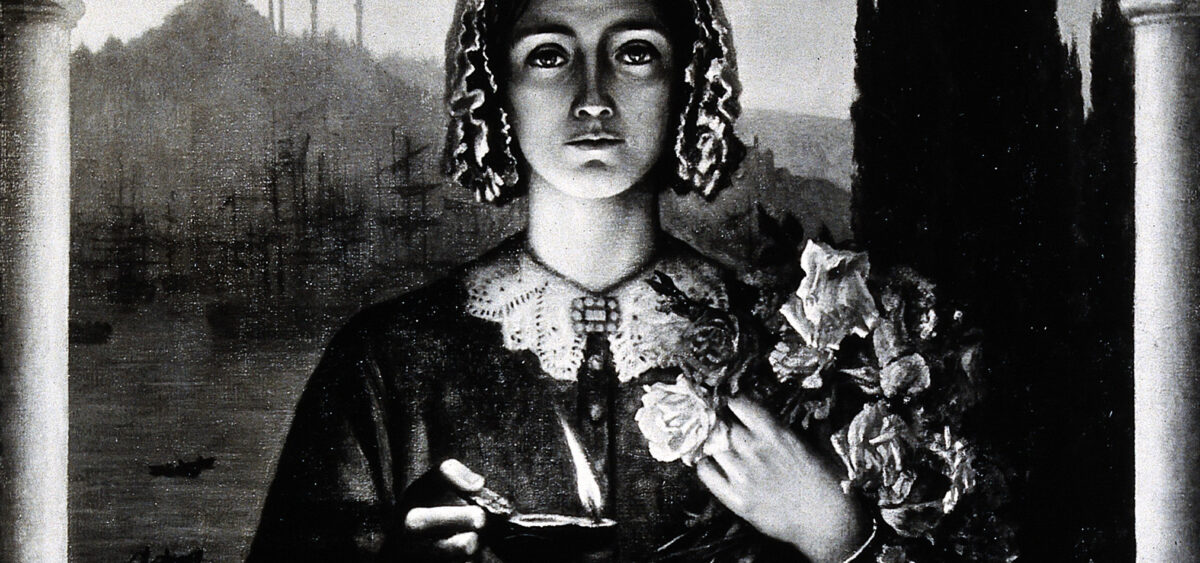
She was wrong about many things, but there was one she managed to foresee despite the limitations of her times. In illness, she perceived an experience that comes from nature. She saw it as a process that requires not only medical intervention, but also understanding, empathy and presence. Florence Nightingale stood in the doorway that led to a new era in medicine and took to opening the windows.
Her bicentennial birthday anniversary would have been a fantastic opportunity to celebrate the life and work of the nursing icon she was. However, the circumstances had forced the Abbot of Westminster to honour Florence Nightingale only symbolically. He prayed for the nurses working on the front line of defence against the coronavirus. The abbot thanked God for bestowing them with bravery, compassion and perseverance.
Each year, on 12th May, a great crowd gathers in the most important church of England. There are nurses, medical students, Red Cross representatives and the military. The culminating point of the event is a procession of nuns who carry a small olive-oil lamp (an attribute of Florence Nightingale in her portraits and prints) and bring it to the main altar. There, the nursing sister hands it to a qualified secular nurse who works in a hospital. This gesture symbolizes the passing of knowledge and bringing humanity from the darkness into the light. Then, as tradition has it, the abbot places the lamp on the altar.
This year, on a late Tuesday morning on 12th May, the only person standing in the Nurses’ Memorial Chapel was Arlene Lee, a nurse from Southampton General Hospital. The Abbey’s windows were lit in the blue of the NHS. Arlene’s colleagues from the National Institute for Health Research were delegated to care for COVID-19 sufferers. Arlene was left alone with the lamp that is kept in the Chapel – a symbol of the never-ceasing care for patients. Later, the Southampton nurse said to journalists that it was a very special moment for her. As a Florence Nightingale Foundation scholar, she owes a lot to her patron. If not for the pandemic, she would have spent last spring on the Harvard University leadership and management programme.
Healthy management
Sister Nightingale would have liked such concepts as ‘management’ and ‘leadership’. Her parents named her after the great Italian city in which she was born in 1820. She would have also liked to see nurses look after their patients instead of wasting their time on unproductive rituals. In her view, service to others was nurses’ most important vocation.
She did not like attention, and avoided acclaim and recognition at all cost. She didn’t want only to work with her biographers or receive honours while locked in an ivory tower of glory, surrounded only by a narrow coterie of her closest colleagues. She was almost unreachable. After Queen Victoria herself, Florence was the second most popular and written-to woman in Great Britain. Adored by the general public, she was respected even in the conservative, oldfangled circles of parliament.
Sister Nightingale appreciated her position and status as a secular saint only for the opportunities they gave her: to make her voice heard and heeded by those in power. That was where she wanted to carry out her plan to heal the world of its imperfections and surplus of unnecessary suffering. Unlike the populace, who wanted to see her as an angel of kindness and the saviour of those dying alone and forgotten, Florence Nightingale saw herself mostly through the mist of disappointment. For years, her thoughts pulled her back to those she had failed to save, and to the numbers that signified the pain and death that she believed possible to avoid. Glorified and turned into a living icon of kindness, she was actually a bitter character. A pragmatist, firm in her belief that health must be cultivated and protected through the appropriate procedures; an unwavering promoter of hygiene and cleanliness; married only to her work and ideals, which even now, over a hundred years after her death, we hardly meet.
Today, the down-to-earth, uncompromising spirit of Florence Nightingale would be of great help in hospitals across the world, from the US to the Philippines.
The coronavirus pandemic is a catastrophe that requires instantaneous and effective changes in how we care for the infected and the ill. COVID-19 ambushed doctors all over the globe, forcing us to immediately reorganize intensive care units, come up with new ways of isolating the infected, remodel the entire hospital infrastructure, provide appropriate personal protection equipment to medical personnel, and swiftly transfer the staff from one specialization into another. It forced us into running real-time research, analysing the changing threats and statistics, as well as learning the behaviours of the new enemy.
Due to the forced isolation of COVID patients, the pandemic led nurses and doctors into a whole new level of commitment and compassion – they are the only ones who accompany the dying in their final moments. They stand in for loved ones, pass last words over the telephone, hold their patients’ hands. It is them who, drenched in sweat, masked and shielded, attach selfies to their chests to help patients remember that inside the suit and mask, there’s a person ready to stay with them. It is also a time of dramatic choices, which have to be made when the numbers of critically ill are soaring. It’s the reality of quick assessments and choices about whom to save. Many hospital workers call it a state of war. And history shows that wars often make room for revolutionary changes.
Strength of character
The steamer ‘Vectis’ left Marseille for Constantinople on Friday 28th October 1854. Onboard this unassuming converted mail carrier was Florence Nightingale with a group of 38 hospital nurses and trainee nuns.
The Crimean War was on. This was a conflict that forever changed the perception of the suffering soldiers experienced in the field, to the same extent as the Vietnam War did a century later. Thanks to press reports, access to telegrams and personal testimonies written by soldiers in their letters to their families, the Crimean War shook public opinion and revealed the horrid truth about the victims. At the same time, it gave way to new expectations. Reports on mass deaths, awful conditions in field hospitals and diseases decimating the royal army moved the British public deeply, and it demanded better care for the privates. They wanted the war to be managed better.
As a response to public pressure, 34-year-old Florence Nightingale was employed to improve the fates of the British soldiers. Coming from a family of bankers and merchants, Florence had little experience herself. She received several weeks’ worth of medical training in a German hospital, she watched hospital sisters in France, and helped look after patients in British infirmaries, like many other well-born girls. What she lacked in expertise, she made up for in her strength of character and determination, which earned her respect and trust despite her young age and social standing. Just a reminder: this was all happening in the mid-19th century, when the list of activities appropriate for noble-born ladies included crocheting, reading poetry and raising children. They were expected to never encounter anyone of lower social status than their own, except for the staff they employed at home.
Florence was a well-to-do lady, persistent in her groundbreaking efforts to become a nurse (Britain was far behind France and Germany, and had no civilian nurses to support doctors and patients in hospital wards), and she managed to leave an impression in the right circles, where she was viewed as determined and passionate. Before reaching the age of 30, she had already made a rather original self-defining statement. Florence fell out with her family, having declared that she had no intention of getting married as she planned to commit to her nursing career fully. Her relatives might have been furious, but they were hardly surprised. Even as a little girl, Florence wrapped her dolls in blankets (declaring them “poorly”) and noted all the symptoms of any ailments the household members would exhibit. In 1854, when the government began frantically searching for a way to address the public’s demands, all recommendations pointed at Florence Nightingale.
It wasn’t her first long-distance trip. Florence had already travelled across Europe, and she had even visited North Africa. She spent the whole journey tormented by seasickness, but she had no time to make a fuss. As soon as the ship arrived on the shores of Anatolia, she heard of the tragic Battle of Balaclava, where the allied armies of French, British and Ottoman soldiers had fought Russian troops. The light cavalry charge of the British brigade reaped a mortifying number of victims. On the very same day, 400 wounded soldiers were brought to a field hospital near the base in Scutari on the Asian said of the Bosporus (nowadays known as Üsküdar; a district in Istanbul). During the days to come, the medics had to admit up to 800 patients a day. And more battles followed.
The cleaning frontier
Nightingale and her team of trainee nurses were to live in the tower of a building that housed a British regiment; part of the building was turned into a hospital. The job tasked to the female team – working in a military hospital – was unprecedented, and the team had to adhere to strict army rules. At first, doctors and officers approached the idea with a dose of scepticism. In the meantime, the Scutari hospital was hell on earth. Soldiers died in their beds – festering wounds were putrefying, arms and legs consumed by gangrene, mattresses and unchanged sheets were soaking up faeces and urine for weeks on end, moulding and reeking of rot. Shirts were heavy with pus, sweat and blood. Cockroaches were everywhere, and rats skittered about in the corridors. The patients were going down with fever, as well as wound and intestinal infections. There wasn’t enough water or food, and whatever was available could hardly pass for sustenance. Moulding bread, raw meat, leftovers that only led to new diseases. There were no fresh provisions. The thick stench of death and suffering hung low in the stuffy, dramatically overcrowded rooms and in the corridors, echoing with excruciating screams and moans. Those who didn’t cry out in pain just stared numbly at the ceiling or were delirious with fever.
Florence wrote to her family about the “unspeakable horrors” she saw, but she didn’t wait for anyone’s permission to get to work. She had her nurses begin with cleaning the place; they scrubbed the floors, sewed bandages and fresh shirts for the wounded. With nubs of chalk, they drew lines on the floors to separate the patients, keeping them at a safe distance from one another. They began opening doors and windows to allow fresh air circulation. They did essential shopping. When Florence’s mother found out that her daughter was wandering the markets on her own, she was sick with worry. Meanwhile, Miss Nightingale was interested only in improving her patients’ situation and managing her team. The group of women she brought with her consisted of nurses she had selected herself, based on their experience and conversations in which she had tried to determine their morals. For her entire life, Florence believed that it was ethics and personality that made for the most important qualifications when working with patients. The women who sailed to Scutari with her came from lower social classes. To them, carers’ work was either a means of making money, or a last chance for the unmarried and impecunious. Their motives were much less noble than those guiding their matron. For this reason, Florence introduced strict discipline: no inappropriate conversations or contact with patients, no alcohol, no disorder. The enforcement of the rules turned out to be moderately successful.
Over time, Florence’s nurses managed to improve conditions for the wounded. They built new beds and made sure that every patient could bathe twice a week. Among the more progressive solutions introduced by Miss Nightingale was the idea to set up a little curtain around each bed. This way, soldiers who still had their limbs intact wouldn’t see the horrid amputations the other patients were going through. She did not allow amputations of arms and legs that were not infected – and her adherence to hygiene and good care helped the patients get better. The mortality rate started to go down.
An explosive combination
Miss Nightingale was a pioneer in more areas than just hospital care management and maintenance of hygiene. She was an advocate of frequent hand-washing with soap and warm water, and promoted the idea of airing the rooms long before anyone could prove the existence of bacteria and viruses. But above all, she was progressive in her approach to the emotional and mental state of her patients – half a century before the birth of modern psychotherapy. However, Florence’s work in all these aspects is not completely unambiguous, making it impossible to portray her as a progressive feminist and a pioneer of egalitarian, science-based ideas.
The paradox of Miss Nightingale’s biography lies in the fact that in many of her trailblazing discoveries, she followed her intuition and faith in God. At the same time, she was known for her conservative – while utterly unusual – views. The radical advancement in patient care, along with the development of civil (rather than church-based) nursing were possible because of Nightingale’s worldview and personal qualities. She was a devoted Christian who considered tending to the sick a missionary duty. Hence the so-called ‘Nightingale syndrome’, sometimes used to mock those determined to save and help others no matter the cost, often with a pinch of obsessive control and disregard for rational thinking. Christianity brought a certain perspective into the developing profession of nursing: it imposed the moral discipline and purity of intention that became a sort of a uniform to protect women. It was meant to help the nurses persevere in their position of servitude that required endless patience and empathy.
The healing power of numbers
Still, Miss Nightingale was remarkably down-to-earth. She believed that those who exhibited the right morals could only learn how to become nurses through practice – by tending to patients. She did not believe in academic education and was a firm supporter of traditional gender roles: only men could be doctors, and the role of women was to look after patients. Nightingale’s personal courage in standing up to her social class and to the customary ways of limiting women’s professional choices had nothing to do with any liberal stances. Florence Nightingale didn’t want the right to vote, and it took her a long time to begrudgingly accept the progress of women’s liberation to which she actively contributed. But, to make this portrait even more complicated, we should add that as a nurse, she used mainly logic and numbers. As a teenager, she loved mathematics and even took special lessons, albeit not for long and against her mother’s wishes. Her passion for mathematics would help her create one of her longest-lasting achievements.
Today, infographics and diagrams are a popular way of presenting sets of data. These simple graphs allow us to quickly understand the scale and meaning of various phenomena. And it is Florence Nightingale to whom we owe their prevalence in our daily life. It would be difficult to imagine following the results of parliamentary elections or the statistics of the infected, dead and cured of COVID-19. Miss Nightingale was passionate about statistics, considering it her most important ally in confirming the intuitive guesses and observations she made in her wards. In her key reports from the Ottoman Empire, she presented data to the government using graphs and diagrams.
In Scutari, she counted and measured everything she could: the space given to each patient, food rations, drug dosages and, above all else, the deaths. These numbers and comparisons helped her find out why patients were dying and how to prevent it. By connecting healthcare to statistics, Florence built a bridge between medicine and mathematics. She provided hospital treatments with solid foundations for scientific development. Upon her return to Great Britain, she wrote a report that became a great-grandfather to modern analysis methods. Today, the very same methods lead to long-term political decisions and management strategies. Miss Nightingale ran her calculations and proved that men in Scutari were not dying from their wounds, but rather from dysentery, cholera, diarrhoea, dehydration and various infections.
She was wrong to believe it was miasmatic air that carried fever and diseases (it wasn’t until much later that Lister, Pasteur and Koch gave us proof of the real culprits: germs and bacteria). She was reluctant to accept the report of a committee establishing that many of the Scutari deaths were caused by a poisoned water source. A dead horse (among other gruesome findings) was discovered in the waterways that ran under the hospital. And yet, the committee would have never visited the hospital if not for Miss Nightingale’s persistence in her quest for reason and explanations.
She was not wrong, however, to believe that cleanliness, a proper diet, good lighting and fresh air are all key ingredients to the whole process of recuperation. She was also right to insist on designing spacious and airy hospital buildings, and to demand precise standards and procedures in nursing practice.
After the Crimean War, Nightingale opened a nursing school at St. Thomas’ Hospital in London, and while she never stopped valuing practice higher than theory, she still believed future nurses needed to know basic mathematics and Latin. Only this way could nurses work with doctors when administering drugs and agreeing on the right dosages. To Florence, the hospital was a place of care as much as it was a well-controlled war zone; there, battles were won through the strength of spirit and efficiency of management.
Angel in a cap
Her famous image – of “the Lady with the Lamp”; a gentle and compassionate figure moving at night among hospital beds – was not made up. There were many witnesses to Florence Nightingale’s work who vouched for her endless patience and kindness towards patients. She knew how to comfort the suffering and how to give them a sense of dignity; in her opinion, it was at the forefront of every nurse’s main duties. However, the cogs of history pulled this part of her achievements into an avalanche of changes that came at the turn of the century, when science, industrial revolution and a cultural shift merged together. Miss Nightingale’s strict rules for nursing suddenly lost their relevance as new ideas replaced them.
Today, nurses study at universities and spend years training in theory before they can be let into clinics and hospitals. As for the saintly patience and kindness, while still fitting into the ideal as imagined by patients, they have been overtaken by the ability to make quick and professional needle inserts, administer drugs, and change wound dressings. In a way, Florence Nightingale is the one responsible for the superhuman expectations we have of nurses to this day. We aren’t surprised by the coldness and selective focus of doctors, who are interested in nothing but their diagnoses and procedures. But when it comes to the women we call ‘sisters’ (and the few and far between men in the field), we expect them to be compassionate, attentive and subtle. Meanwhile, their work conditions are no less ruthless than those Nightingale encountered in Scutari, albeit in a different way.
Florence spent two years of service in the Ottoman Empire. She moved from Constantinople to Crimea, where she suddenly contracted Crimean fever, also known as brucellosis (typically caused by bacteria found in livestock, such as goats and sheep). The first stage of her illness manifested itself with fever and joint pain. Up until her death, Nightingale suffered from recurring symptoms that unfolded into a complex spectrum of pain. Five years after her breakthrough achievements in Scutari, she was bedridden. She set up a small command centre in her West End Burlington hotel suite. She wrote, published and worked without respite. Together with a few male colleagues (whom she considered helpful in getting her point across at the highest levels of power and opinion), she published influential reports, sharing her recommendations and expertise. She influenced the new standards of building and organization of hospitals; she even fought for improving healthcare in India, the pearl in the colonial crown that she never got to visit, although she wrote about it with excellent expert knowledge that she gathered from a variety of sources.
Florence was said to be tirelessly persistent. At the same time, she suffered from sharp lumbar spine pains, joint aches, depression, anger attacks, and other mental health issues caused by brucellosis. Even though she lived in the murky, stuffy rooms of central London, she maintained a worldly perspective and never stopped writing and working on her analyses, even in the very last weeks of her 90-years-long life. As a 30-something, she was expected to die young, and yet she outlived all of her family. She passed away in 1910. Five years later, her monument was unveiled in London without much fuss. The Great War was spreading through Europe; corpses covered the fields around Ypres and Marne.
Natural care
Florence Nightingale never married; she had no children. Her most far-sighted and important publication was a thin brochure titled Notes on Nursing from 1859. Written for those who had to look after the sick at homes, it was a practical, accessible guidebook to proper conditions and ways of taking care of patients. In that little booklet, Florence made several observations that turned out to be astoundingly timeless and long-lasting. Her non-scientific perspective on the nature of illness is also very interesting – Florence focused less on pathological process, and more on the self-healing properties of the body. She wrote that it is nature that heals us. She considered fever and pain to be manifestations of healing. What she cared about most was the patient’s comfort, along with the aforementioned proper lighting, airing and nutrition (she called for individual diet plans for every person and ailment). She wrote about the emotional and spiritual aspects of healing, and found them essential in the healing process; she wrote about the need for gentleness and compassion, and about the impressive endurance and strength of her patients. The world considered her a hero, but the only heroes she knew were the sick and wounded. Miss Nightingale admired their hope and patience in enduring pain back in a time when general and local anaesthesia were a pipe dream, and the choice of drugs and methods sparse, to say the least.
The mass suffering of the Crimean War and the other armed conflicts that came after helped to speed up the development of medicine; the next century brought more lightning-quick changes. Today, remote-controlled robots can perform surgeries, asepsis is gospel at any hospital ward, and the process of convalescence is considered as important as the procedures themselves. But the most elusive aspect of medical care – the apple in Florence Nightingale’s eye – seems to be among those most endangered. Today’s approach to healthcare is becoming an extremely pragmatic and management-focused industry, ruled by the indexes of effectiveness and return. And this leads to the abandonment of the ethical aspect of it. Empathy and compassion for someone else’s suffering, the ability to share our time – these qualities create the subtle conditions needed for healing, and they float high above the heads of today’s medical staff. This is the most difficult standard to meet, and it was very apt of Florence Nightingale to view nursing as character-driven vocation. She was also right when she wrote that no school could teach it. To stay with another human being through their suffering is a spiritual practice we can only live through.
In researching this article, I used the following books: “Florence Nightingale: The Woman and Her Legend” by Mark Bostridge (Penguin, 2009); and “Notes on Nursing” by Florence Nightingale (reissued; CreateSpace, 2015).
Translated from the Polish by Aga Zano










